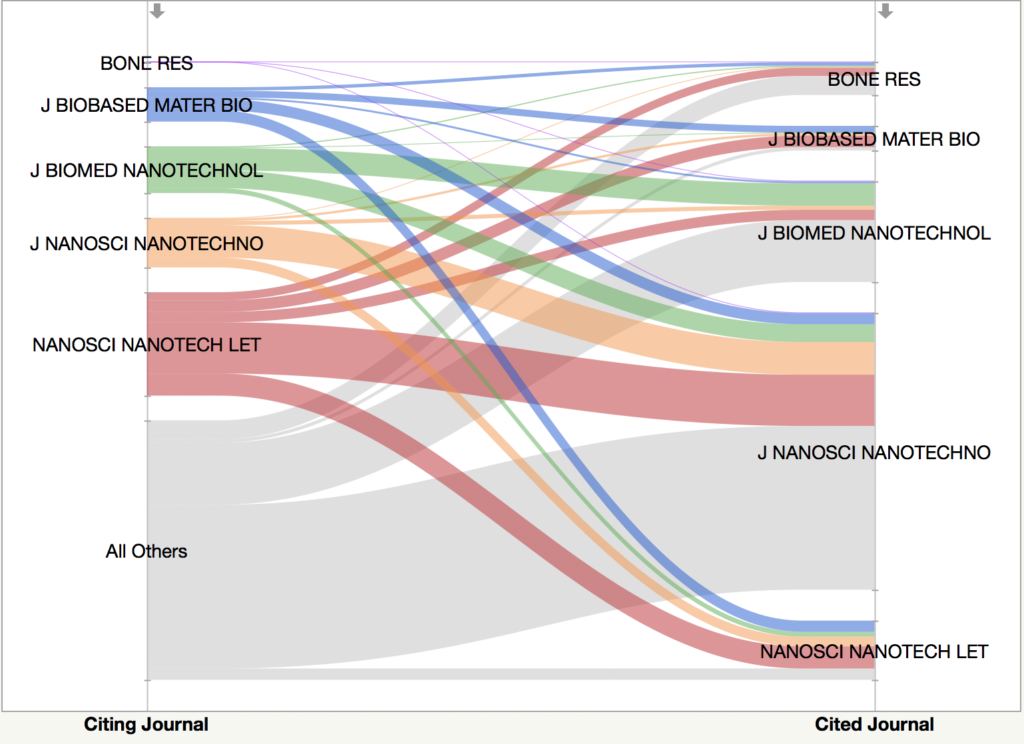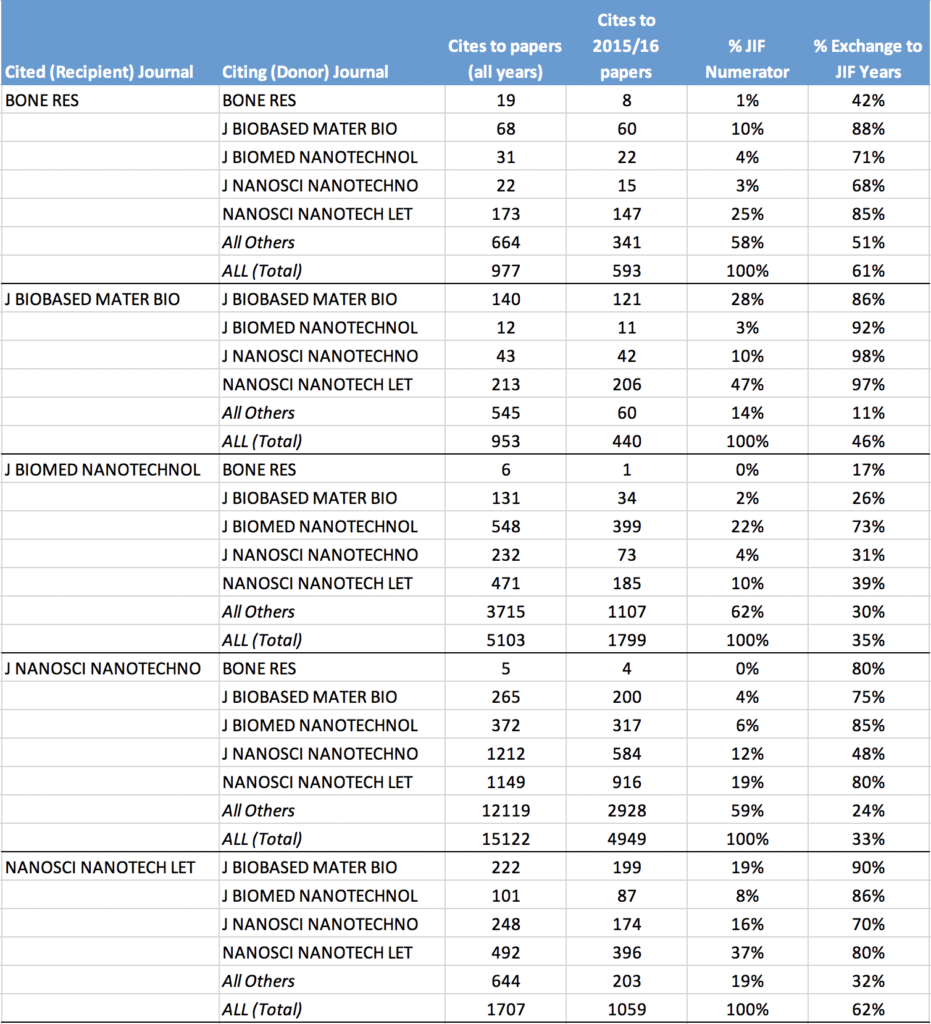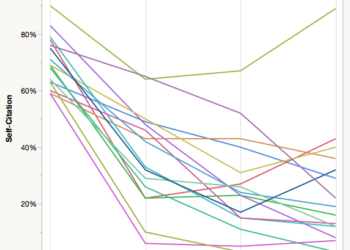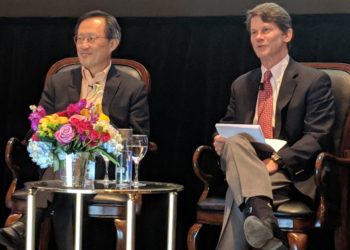Update: On 20 June 2019 Clarivate issued an update to their Editorial Expression of Concern, suppressing three ASP journals (Nanoscience and Nanotechnology Letters, Journal of Biobased Materials and Bioenergy, Journal of Biomedical Nanotechnology) along with Bone Research.
When Bone Research received its first Journal Impact Factor (JIF) in 2014 (a meager score of 1.310), it didn’t receive much notice. The following year, Bone Research‘s JIF more than doubled to 3.549, then nearly tripled to 9.326 in 2016. This year, it received a score 12.354. It now is ranked second among Cell and Tissue Engineering journals.
In June, Clarivate Analytics, the company that calculates JIFs and other journal-level performance metrics, issued a bone-rattling Editorial Expression of Concern for Bone Research and four other journals, citing a “problematic pattern of citations” and “a particular concentration of citations to the journal Bone Research.”

Bone Research is a journal published by Springer Nature, in partnership with the West China School of Stomatology, Sichuan University, and the International Chinese Musculoskeletal Research Society.
The four other journals (Nanoscience and Nanotechnology Letters, Journal of Biobased Materials and Bioenergy, Journal of Biomedical Nanotechnology and Journal of Nanoscience and Nanotechnology) are all published by American Scientific Publishers (ASP). The contact information for ASP lists a suite in a small office complex in Valencia, California, a suburb of Los Angeles. The founder, president and CEO of ASP is Dr. Hari Singh Nalwa, who also serves as Editor-in-Chief of two ASP journals. ASP is listed on an archived copy of Beall’s List of predatory publishers although it does not appear on either Cabell’s whitelist or blacklist of scholarly journals.
Bone Research is a very small journal. In 2015 and 2016 (the publication years used to calculate its latest Impact Factor), it published just 21 and 27 papers, respectively. In 2017, these 48 papers received a total of 593 citations, 244 of which came from the four American Scientific Publisher journals listed above. If we removed these citations, Bone Research‘s 2017 Impact Factor falls from 12.354 to 7.271 but still retains second place in its subject category.
This is a big change in score, but Bone Research performs well even without this large flow of citations from ASP journals. There were 200 other journals that cited Bone Research papers in 2017. Nevertheless, the construction of the Journal Impact Factor — a simple ratio of citations to published papers — is highly sensitive to citation irregularities among small journals, and Bone Research is a very small journal.
While Bone Research appears to have benefited from citations from four ASP publishers, the relationship was not mutually beneficial. In 2017, Bone Research cited just two of the four ASP journals and contributed just 5 JIF-directed citations to their scores (see Table). The more problematic pattern in citations appears to be found in ASP journals citing themselves.

The Journal of Biobased Materials and Bioenergy (JBMB) received a total of 953 citations in 2017, nearly half (440 or 46%) of which were focused on papers published in the previous two years (years that form the basis of its Journal Impact Factor calculation). Nevertheless, nearly all (206 of 212, or 97%) of citations from Nanoscience and Nanotechnology Letters were directed to JBMB‘s JIF, as were 98% (42 of 43) citations from the Journal of Nanoscience and Nanotechnology, and 92% (11 of 12) citations from Journal of Biomedical Nanotechnology. Self-citations from JBMB were equally focused on its JIF publication window (121 of 140, or 86%), see Table below. In contrast, just 14% of references from other journals cited JBMB papers published in the past two years. If we removed ASP citations, JBMB‘s Impact Factor would drop from 2.993 to just 0.408.
Similarly, Nanoscience and Nanotechnology Letters (NNL) received 1059 JIF-directed citations, 460 (43%) of which came from the three other ASP journals, and another 396 (37%) from itself. 81% of these citations contributed to NNL‘s JIF calculation, compared to 19% of citations from other journals. Without ASP citations, NNL‘s JIF would drop from 2.917 to just 0.559.
Clarivate’s Editorial Expression of Concern, published on the same day that the Journal Citation Reports (JCR) were released, stated that their editorial team was was undergoing an investigation and may take further action, such as journal suppression from the JCR and removal from the Web of Science.
Stephen Hubbard, Content Team Lead for the JCR responded to my inquiry by email that no further action was taken: “The investigation in regards to 2017 JCR data is closed. Journal selection continues to monitor these journals to ensure they meet our standards for coverage.”
Dr. Hari Nalwa, CEO of American Scientific Publishers and EiC of the Journal of Nanoscience and Nanotechnology (one of the journals named in the expression of concern), responded to my media inquiry stating that “China researchers [sic] were the cause of the problem” but refused to provide any more details of the problem or how it was resolved with Clarivate. “This problem has been resolved so there is nothing to say,” Nalwa added.
The JCR has a public document explaining the guidelines it uses to evaluate journals for suppression. However, as illustrated through reverse engineering previously suppressed titles, threshold levels are set extremely high, so high, that a journal that increased its Impact Factor by nearly 5-fold and moved to first-place among its subject category can escape suppression.
By remaining silent, Clarivate is hiding skeletons in their closet.
When an editorial team issues an expression of concern, it is because it has just learned of a serious problem that requires time to investigate and to take action. Only credible allegations should be made public since expression of concerns can do serious damage to the reputations of people and publishers. Indeed, such public allegations must be followed with public statements. In the case of Clarivate’s concern, it should have either suppressed journals or issued a public statement that it had undertaken an exhaustive investigation and could not find any cause for concern. Either way, Clarivate should have issued a separate statement.
There should be no bones about it. By remaining silent, Clarivate is hiding skeletons in their closet.
Table Notes: % JIF Numerator is the percentage of citations from the citing (donor) journal that form the numerator of the citing (recipient’s) Journal Impact Factor calculation. % Exchange to JIF Years is the proportion of citations from donor to recipient that are considered in the JIF calculation.
Discussion
11 Thoughts on "Skeletons In Their Closet: Clarivate Issues Editorial Concern But Takes No Further Action"
It might be a coincidence, but the editor-in-chief of “Nanoscience and Nanotechnology Letters” is the same person as one of the editors-on-chief of “Journal of Biobased Materials and Bioenergy”, who is also the Asian editor of “Journal of Biomedical Nanotechnology” and one of the associate editors of “Journal of Nanoscience and Nanotechnology”.
Is there a conflict of interest in being both the CEO of a company and acting as an editor in chief on a journal (or multiple journals) based on a business model that increases revenue with each paper accepted? Usually in the publishing world, we try to build a strong firewall between the editorial functions of a journal and its financial performance (we want editors to objectively review each paper and make their decision based on the paper itself, not on the financial benefit it may bring to the company behind the journal). Is such a firewall possible when the CEO of the company is the one making the editorial decisions?
If so, then Frontiers needs to be given a hard look. See: https://thegeyser.substack.com/p/is-plan-s-built-for-greed.
These kinds of conflicted relationships between editorial and business shouldn’t be allowed.
Increasingly, I see that the overlap between business and editorial functions is getting blurred. So the approach of focusing on these overlaps, as a means to reduce questionable practices to improve impact metrics, may not work in the long term; there are just too many points of failure. The best approach that may work in the long term would be better managing the calculation of these metrics through better checkpoints at the JCR editorial team workflow and impact calculation process.
American Scientific Publishers charge to read content ($105 per paper), so you won’t find them in OA blacklists. IIRC, Beall felt strongly enough about them to make an exception to his usual OA-only rule.
I’m pretty sure I’ve read several times in this very blog that JIF suppression merely punishes the researchers who are unlucky enough to author papers for the suppressed journal in the year that it is suppressed.
So what action should Clarivate take that won’t hurt researchers and their reputations?
Indeed. Journal suppression have severe consequences for authors, especially for those who do not have job protection (i.e. tenure), and for those who are rewarded for where they publish. Early career researchers may suffer the most.
I don’t think it is possible to isolate the problem and insulate the reputation of authors from the reputation of the journals in which they publish: Both are inextricably linked. Authors benefit from the reputation (or JIF) of the journal when it is high, but also suffer the consequences when the journal reputation is damaged. You can’t have one without the other.
Bone Research is ranked #2 of 209 journals in the field of “Endocrinology, Diabetes and Metabolism” with a CiteScore of 10.85 in 2017 according to Scopus’ CiteScore Metrics. The journal is also categorized as “Histology” (#2/61) and Physiology (#5/169). There are 65 documents during the 2014-2016 period, which have received 705 citations in 2017. The numbers are very similar to Web of Science, although I am not aware any expressions of concern from Elsevier/Scopus.
Scopus has a Content Selection and Advisory Board
https://www.elsevier.com/solutions/scopus/how-scopus-works/content/scopus-content-selection-and-advisory-board
However, I don’t believe this group has been used to express any concerns or suppress any titles in their index.
My bad (I was partially wrong): Scopus has an Excel-file of discontinued titles (https://www.elsevier.com/?a=212275) and 3 of 4 of the above mentioned American Scientific Publishers journals are not indexed in Scopus anymore, along with 6 other ASP journals, although Bone Research is not on the list.
I also found a Nanoscience and Nanotechnology Letters article in Web of Science “Sliver [sic] Nanoparticle-A Promising Anti-Mosquito’s Agent: A Review” (DOI: 10.1166/nnl.2017.2586). This article was published in December 2017 and has 286 references. It cites 34 of the 48 2015-2016 articles in Bone Research. There are at least a dozen other articles in the December 2017 issue of Nanoscience and Nanotechnology Letters which heavily cite Bone Research articles, although for some reason none of these are counted for the 2017 JIF of Bone Research.
I also noticed, that the Retraction Watch has already published a post about this topic (https://retractionwatch.com/2018/06/26/high-profile-indexing-service-punishes-20-journals-issues-unusual-warning-about-five-others/). Someone in the comments found a copy of one Nanoscience and Nanotechnology Letters article on ResearchGate: (https://www.researchgate.net/publication/323450496_Towards_Highly_Linear_High_Resolution_Successive_Approximation_Register_ADCs_for_the_Internet_of_Things). This article has 9 “normal” references, and in the conclusion part the final sentence is the following: “Finally, it was found that nanomaterials have been paid much attention for their preparation,10–31 modification, 32–55 and applications 56–75 in various fields, 76–95 we believe our research will be helpful for nano-sensing technology.”, which adds 86 extra references, including 11 Bone Research articles among many others. This might explain what happened, although it is not clear why did the authors include this last sentence.
Additionally: one of the editors of Journal of Biobased Materials and Bioenergy has the same name and affiliation as one of the executive editors-in-chief of Bone Research.




